
Benque Viejo del Carmen ("Benque") is the westernmost town in Belize, 130 km (81 mi) by road west and south of Belize City, at the Guatemalan border. San Ignacio lies 13 km to the east and Melchor de Mencos just across the border. The Mopan River runs along the town's north and west edges.
A vicar is a representative, deputy or substitute; anyone acting "in the person of" or agent for a superior. Linguistically, vicar is cognate with the English prefix "vice", similarly meaning "deputy". The title appears in a number of Christian ecclesiastical contexts, but also as an administrative title, or title modifier, in the Roman Empire. In addition, in the Holy Roman Empire a local representative of the emperor, perhaps an archduke, might be styled "vicar".

Saint Patrick Catholic Church, Honolulu is a parish in the Kaimuki district, in the East Honolulu Vicariate of the Roman Catholic Diocese of Honolulu, Hawaii. The church was consecrated under the title of St. Patrick, Bishop of Armagh. Its Romanesque architecture, as well as its fine ecclesiastical appointments such as stained glass windows and pipe organ, are attractive to prospective couples seeking nuptial rites.
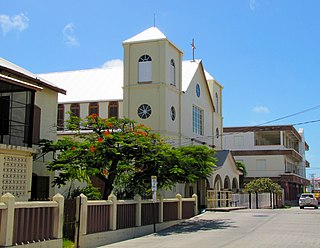
The Roman Catholic Diocese of Belize City–Belmopan is a diocese of the Latin Rite of the Roman Catholic Church in continental Central America. The diocese comprises the entirety of Belize, the former British dependency British Honduras. It is a Latin suffragan of the Archdiocese of Kingston and a member of the Antilles Episcopal Conference, yet still depends on the missionary Roman Congregation for the Evangelization of Peoples.

The Roman Catholic Diocese of Montego Bay is a Latin suffragan diocese of the Roman Catholic Church located on the northwest part of the island of Jamaica, in the Caribbean ecclesiastical province of the Metropolitan Archdiocese of Kingston, yet depends on the missionary Roman Congregation for the Evangelization of Peoples.
The Roman Catholic Diocese of Multan is a diocese of the Latin Rite of the Roman Catholic Church in Pakistan.

Holy Redeemer Cathedral is a Roman Catholic cathedral in the city of Belize City, Belize. It is canonically the mother church of the Roman Catholic Diocese of Belize City-Belmopan. It shares the role with Our Lady of Guadalupe Co-Cathedral in Belmopan, though the Bishop's offices remain at Holy Redeemer. Pope John Paul II made the first Papal visit to Belize and visited the cathedral in 1983.

David Francis Hickey, S.J. was an American-born bishop of the Catholic Church. He served as the Vicar Apostolic and then the first Bishop of Belize, from 1948 to 1957.
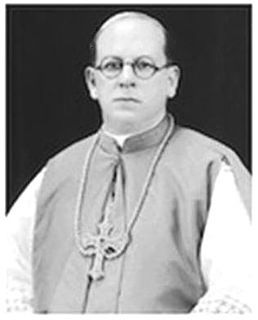
William A. Rice, S.J. was an American-born bishop of the Catholic Church. He served as the Vicar Apostolic of Belize from 1939 to 1946. He was also the founder of Baghdad College.

Robert Louis Hodapp, S.J. was an American-born bishop of the Catholic Church. He served as the second Bishop of Belize from 1958-1983.

Salvatore di Pietro, was an Italian Bishop in the Catholic Church. He served as the first Vicar Apostolic of Belize from 1893-1898. He is widely regarded as the most important figure in consolidating the Catholic presence in Belize in the second half of the 19th century.
Osmond Peter Martin, served from 1983 to 2006 as the third bishop of the Catholic Church for the Roman Catholic Diocese of Belize City-Belmopan.
Dorick McGowan Wright was a Belizean prelate. From 2006-2017, he has served as the fourth bishop of the Catholic Church for the Roman Catholic Diocese of Belize City-Belmopan. Pope Francis accepted his resignation on 26 January 2017 and appointed Fr. Lawrence Sydney Nicasio as the new bishop.

Frederick Charles Hopkins was an English Jesuit and Catholic bishop in British Honduras, Central America, at the turn of the 20th century.

Joseph Anthony Murphy was born in Ireland but raised in Chicago. He became a Jesuit priest and served, inter alia, as dean of the liberal arts college at Marquette University for eleven years and as Vicar Apostolic for the Catholic mission in British Honduras (Belize), Central America, being ordained bishop on March 19, 1924.

Fr. Marion M. Ganey, S.J., (1904–1984) was a Catholic priest, member of the Society of Jesus (Jesuits), and missionary to British Honduras, Central America, from 1937 to 1953, where he was instigator of the credit union and cooperatives movement. He became increasingly prominent in this movement, being invited to the Fiji Islands in 1953 and laboring to establish the movement there and throughout the South Pacific until his death in Fiji in 1984.
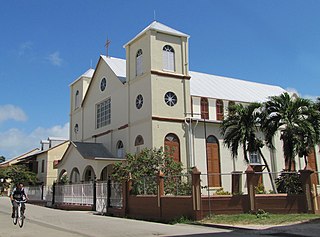
This history of the Catholic church in Belize has three parts: the historical periods of the Catholic presence in Belize, religious congregations laboring in Belize, and apostolic works undertaken.
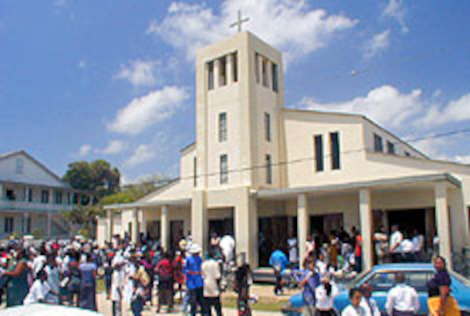
Sacred Heart Church, in Dangriga, Belize, is a Roman Catholic parish.
St. Peter Claver Catholic parish is located in Punta Gorda, Toledo District, Belize.
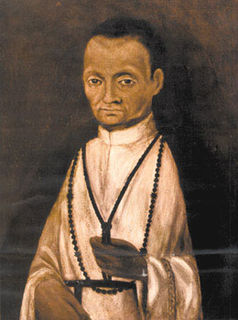
St. Martin de Porres Catholic Church is a Roman Catholic parish on the southwest side of Belize City, Belize, Central America.

















